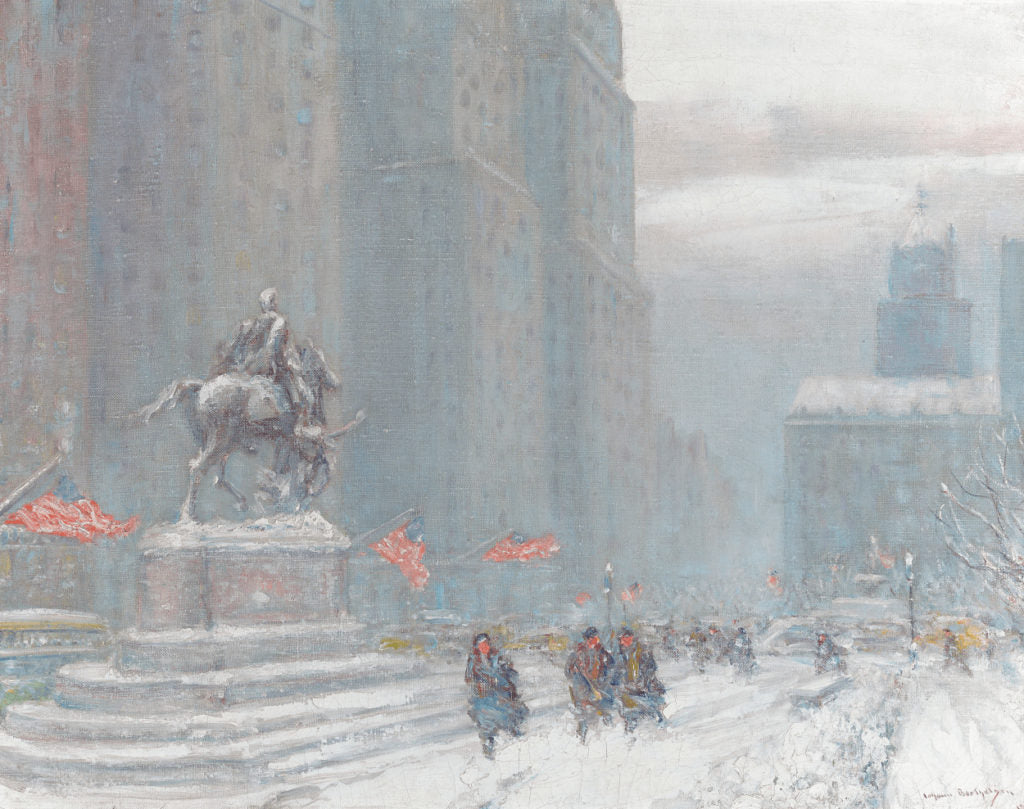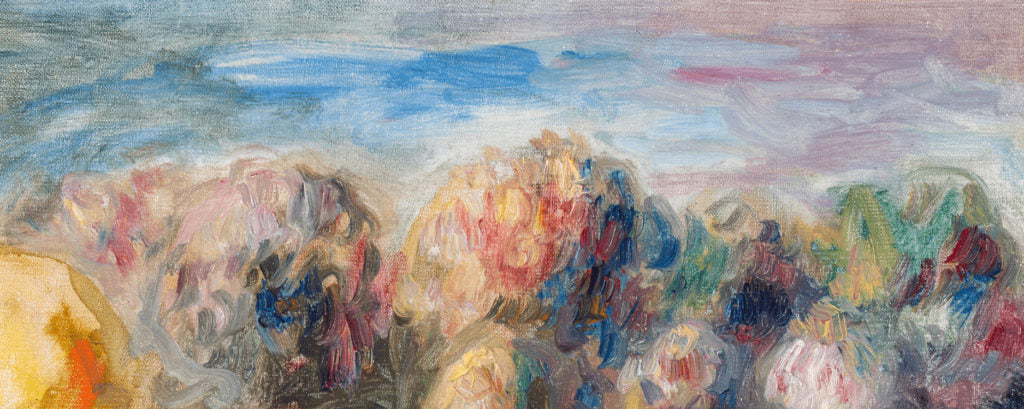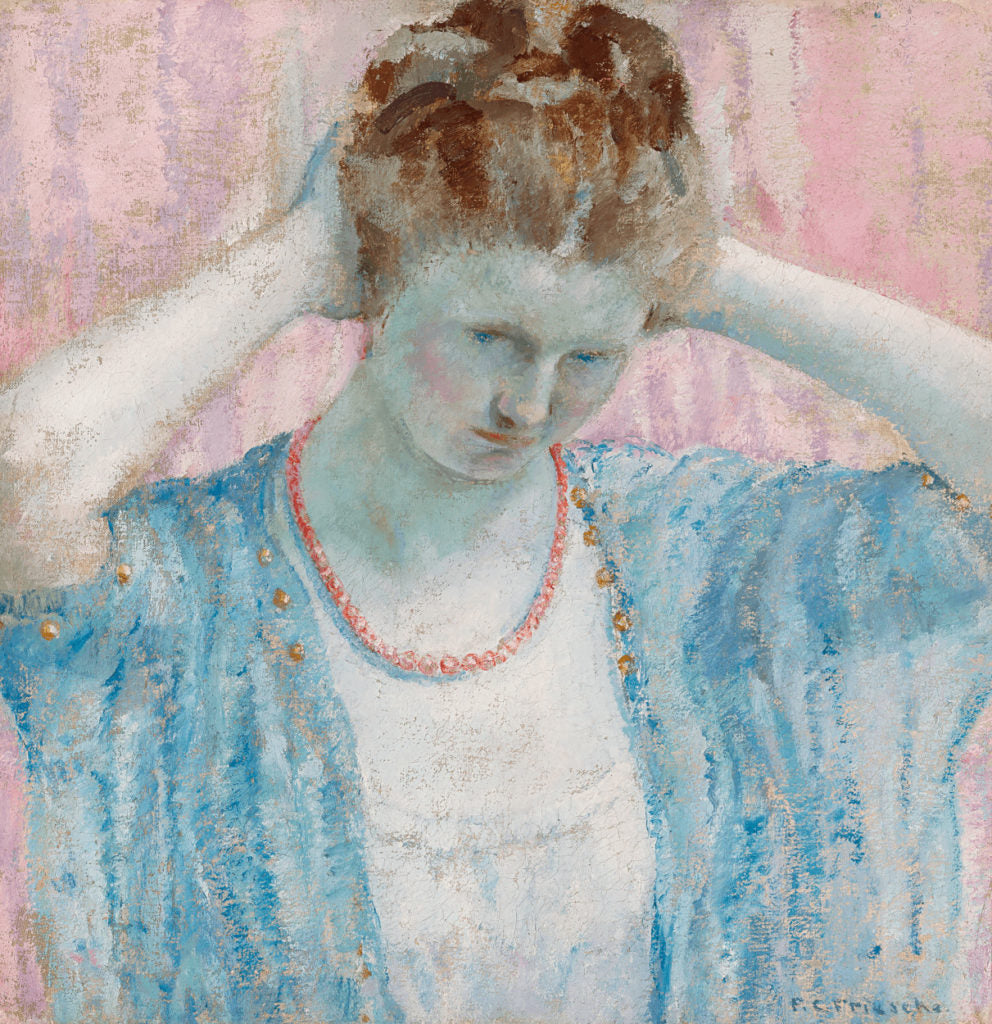Like its French inspiration, American Impressionism sought to capture the fleeting emotion of the moment on canvas through the use of light-filled palettes and painterly brushstrokes. Today, these works are revered among the finest in American art history. Yet, how exactly did this highly modern - and distinctly French - movement come to American shores? Read on to learn more about the evolution of Impressionism in America.
Interested in adding an Impressionist painting to your collection? View our current collection of American fine art, including our most featured Impressionist works today.
What Is Impressionism?
Before delving into the spread of Impressionism, we should first discuss just what makes this style so unique to its predecessors. Originating in France, Impressionism paved the way to a different approach towards art. In fact, the style was originally viewed in a negative light by many critics, who considered it to be a violation of French artistic traditions.
Unlike other art movements during this time, such as Academic art and Romanticism, Impressionist Fine Art focused on everyday subjects. Popular scenes of modern life that were most often seen, such as portraits of women in cafes, a bustling train station, or even a natural outdoor landscape.
Most revolutionary, however, was that these artists sought to capture art in a new way - the focus was not on their subject, but the play of light and atmosphere in a scene. Unlike traditional French paintings that focused on high detail and minute brushstrokes, Impressionist painters used short, broken brush work with pure, unmixed colors in order to capture the raw feeling of a scene.
The Founding Years: Impressionism in France
The story of American Impressionism inevitably begins with the history of Impressionism in France. With the processes of visual perception as their guiding artistic force, the French Impressionists undeniably changed the trajectory of art history in the matter of a few decades. Painting in both urban and rural France, their focus on simplicity and purity in their compositions was a vastly different approach to art than that of the Romantics and Neoclassicists that dominated the French Academy before them. Their wispy brushstrokes gave the impression of a solitary moment in time, ultimately redefining the meaning of art forever.
The first Impressionist exhibition was held in 1874, and it included works by Eugene Boudin, Claude Monet, Camille Pissarro, Edgar Degas, Pierre-Auguste Renoir, Berthe Morisot and a handful of others. It would be the first of eight shows the group would put on over the years. By the final Impressionist exhibition of 1886, they had become public favorites, and collectors were clamoring to purchase their works. Impressionism had taken Paris - and the world - by storm.
Americans in Paris: The Impact of France on American Art
While the Impressionist art movement was on the rise in France, in America collectors were eagerly adding works by European artists to their collections. The post-Civil War era brought a time of prosperity to the country, and newly rich families quickly acquired treasures from Europe to display their newfound wealth. They largely collected artists who were formally trained at the French Academie and were frequent exhibitors at the Salon, such as Jean-Léon Gérôme, Rosa Bonheur, and William-Adolphe Bouguereau. It wouldn't be until the 1880s and 1890s when French Impressionism would become fashionable with American collectors.
In order to better compete with their French counterparts. numerous American artists flocked to Paris, where they enrolled in the prestigious École des Beaux-Arts. They studied the masterpieces that hung in the Louvre, while also learning from their contemporaries who showed works at the official exhibitions and the Salon.
Furthermore, they increased their own credibility by exhibiting their works alongside French painters, proving they could compete with the most elite artists in the world's artistic center. Recognition in the Parisian art world was the aim of every American artist's achievements. Art criticism was highly popular in French newspapers and journals, and French reviews were inevitably picked up by the American press, making positive reviews in Paris essential to an artist's success back home.

Portrait of Laurence Millet by John Singer Sargent
American artists in Paris would certainly have been aware of the French Impressionists, but until the tides shifted in favor of a more modern style, they strictly kept to the Academic style. There were a few notable exceptions to this, however. A handful of intrepid American artists were among the first to embrace the innovative Impressionist style - Mary Cassatt, John Singer Sargent, and James Abbott McNeill Whistler were among them.
Today, these three are regarded among the most important American painters of the late nineteenth century. Just one of them, however, is considered an Impressionist. Sargent and Whistler never did fully adopt the style, they instead developed their own distinctive versions of American modern art. Mary Cassatt, however, completely embraced the new movement. Working side by side with the great Edgar Degas, she became the first and the most notable American Impressionist.
Cassatt spent many years traveling to France and Germany with her family as a child. Although her artistic training started at the Pennsylvania Academy of Fine Arts, she felt that most of her lessons were too rigid and restricting, which lead her to take private lessons in France under the training of painter Jean-Léon Gérôme.
Cassatt was unique not only because she was a woman, but also because she was an American artist who was fully accepted in French artistic circles. While she is regarded as an American Impressionist, she was also a member of the original group of Impressionists - she exhibited in four of their eight exhibitions, and she quickly became one of the key influencers in the original French movement. Renowned for her images of the modern woman in domestic settings, her works were collected by French and American collectors alike, making her an important cultural bridge between the two Impressionist groups. Today, for enthusiasts and collectors, original Mary Cassatt art for sale at M.S. Rau provides a chance to acquire timeless pieces that reflect her pivotal role in this artistic era.
Click here to read more about the American Impressionist Mary Cassatt.
Impressionism Comes to America
Like all fashions, what became in vogue in Paris eventually made its way to America - by the 1890s, American collectors were eagerly scooping up works by French Impressionists such as Claude Monet, Édouard Manet, and Camille Pissarro. This was largely thanks to the work of the French art dealer Paul Durand-Ruel, who organized Impressionist exhibitions in Boston, New York and other major cities throughout the 1880s. Of the American collector's positive attitude towards Impressionism, Durand-Ruel once said, "The American public does not laugh. It buys!"
As wealthy Americans clamored for Impressionist artwork, Americans in Paris naturally also turned to the newly popular style. Many painters flocked the artist colony at Giverny, the French country village where Claude Monet had settled in 1883. John Singer Sargent was among the first Americans to visit in 1885, while others began to arrive in the summer of 1887. The group eventually formed a small American artist colony there, which thrived through the beginning of World War I. Monet himself had little interaction with the group - rather, they gained inspiration from each other and their surroundings. The experience undoubtedly influenced the creation of similar artists' colonies in the United States after these same painters returned home.
And return home they did beginning in the 1880s and 1890s. William Merritt Chase was the first major painter to begin the mass exodus back to America - he left Paris in 1886, and immediately set to work on one of his most famous series of works, Impressionist views of American parks. By 1914, almost all Americans in Paris had returned home in order to escape the dangers of the First World War. They brought with them a distinctly French artistic sensibility but were faced with the challenge of translating their newly acquired French style into paintings that appealed to an American public.

Ten Pound Island by Childe Hassam
The Birth of American Impressionism
The newly repatriated painters settled, for the most part, in the American Northeast. It was the perfect setting for the group, as it was simultaneously historic and urban. Many traveled freely between New York City and newly formed artist colonies in New England towns such as Cos Cob and Old Lyme. In the latter, they captured the historic charm of the early American colonies, while in the city, they could record the country's most important and rapidly expanding urban center. And both were subjects that were distinctly American.
American Impressionism shared many of the same central tenants as its French counterpart. Like the French Impressionists, they depicted scenes of everyday life using natural light, rapid brushwork, and a brilliant palette. They also were deeply interested in capturing scenes of modernity, particularly in the rapidly evolving city. Unlike the French Impressionists, however, they were most concerned with painting places that offered a positive sense of national identity. Instead of down-on-their-luck figures drinking absinthe in cafes, American Impressionists would instead depict bourgeois young women walking in verdant urban parks and gardens or reading on an open terrace.
Bustling boulevards and flag-draped avenues were also common motifs in American Impressionism. Perhaps the foremost practitioner of the urban genre was the great Childe Hassam. Though he was equally adept at capturing the charms of the American countryside, it is his depictions of American flags flying over busy urban centers that have endured as his greatest masterpieces. While he recorded nearly every aspect of life in the American city, all of his compositions are painted in a positive light - he seldom focused on the seedier subjects that are more often glimpse in the works of the French Impressionists.
Click here to read more about the American Impressionist Childe Hassam.

A Summer Idyll by Edmund C. Tarbell
The Ten
Hassam was part of an important group of American artists known as The Ten - a group that followed the example of the French Impressionists in both style and action. They were originally members of the New York-based Society of American Artists, but soon felt restricted by the organization's rigid, conservatives views and hostility towards the Impressionist style. Much like the French Impressionists rebelled against the French Salon, The Ten similarly seceded from the Society of American Artists in 1898 in order to create their own exhibition society. Known as The Ten, the group was comprised of ten members, all of whom vowed to participate in an annual exhibition.
The founding members of The Ten were Frank W. Benson, Joseph Rodefer DeCamp, Thomas Wilmer Dewing, Childe Hassam, Willard Metcalf, Robert Reid, Edward Simmons, Edmund C. Tarbell, John Henry Twachtman, and J. Alden Weir. When Twachtman died in 1902, William Merritt Chase joined in his place. Dedicated to American Impressionism, the group was integral to promoting the style in the American arts community, and each member achieved popular and critical success.
For twenty years the group exhibited in the major American cities, always maintaining ten members throughout its history. It dissolved in 1918, mostly due to the death of its members and a declining interest in American Impressionism. In its heyday, however, it was among the most important organizations to promote the advancement of the new American style.

Mission Cloisters, San Juan Capistrano by Joseph Kleitsch
The California Impressionists
While the majority of the American Impressionists were based in the New England area, the style naturally spread westward to California. The sunshine state seemed to be the ideal place for painting en plein air, and the California Impressionist art movement alternatively became known as California Plein-Air Painting. This regional variation of American Impressionism developed in the early years of the twentieth century, and in true Impressionist style, it primarily focused on the abundant California light.
Much more so than the American Impressionists in the northeast, the California Impressionists were obsessed with the great American landscape. Leading artists such as Maurice Braun, Guy Rose, Franz Bischoff, and Joseph Kleitsch depicted California as an unpopulated and untarnished land, capturing open vista and awe-inspiring views with an impressionistic eye for light and color. Even though sprawling urban centers in San Francisco and Oakland were near at hand, artists preferred to populate artist colonies in Carmel and Laguna Beach. There, they painted lyrical compositions of the areas' natural scenery and expansive coasts, very much in the tradition of Monet at the height of his career.

Mother Holding a Baby Playing with a Toy Duck by Mary Cassatt
Lasting Legacy
Whether located in the east or the west, the American Impressionists offer significant insight into the cultural and artistic development of the United States at the turn of the century. The artists paved the way for the distinctly American modern movements that would follow them. Their innovations in creating artistic organizations and group exhibitions would long outlast the popularity of the Impressionist movement, and many of the greatest American Impressionist painters would go on to teach the next generation of artists.
The group only continues to grow in public interest. A highly important retrospective of the work of William Merritt Chase was held at the Phillips Collection (Boston) in 2016, while Childe Hassam was celebrated that same year at an exhibition at the Peabody Essex Museum (Massachusetts). Most recently from March to July 2018, the Musée Jacquemart-André dedicated a comprehensive retrospective to the great Mary Cassatt. The market interest in these works matches their critical acclaim, making now the perfect time to add a work of American Impressionism to your collection. Browse our selection of original Impressionist art for sale.







